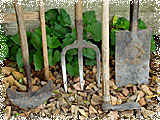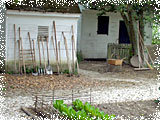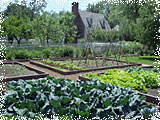| A Special Thanks to HistoricCamdenCounty.Com When Shovels and Dung Forks Were Among Life's Most Important Possessions By Sandy Levins ...
Consider the solid "chunk" of a shovel as you drive it into the soil to prepare the bed -- we hear it and we feel it at the same time. Or the rhythmic "snick-snick-snick" of a sharp pair of hedge shears as they release the fragrance of evergreen around us. And one of the classic sounds of autumn is the dry rasp of the rake as we gather leaves in shapes and colors that delight the eye. Historic tools But, in addition to putting us in touch with our gardens, tools provide a direct link to our heritage that few of us think about when we reach for our favorite shovel, pruner or rake and head out to prepare a new bed, trim a lilac or gather up clippings. When you look into the history of some of the most common garden tools we use today -- their images and descriptions in advertisements and old catalogs -- you find not much has changed in hundreds of years. What has changed, though, is the value placed on those implements. In today's world, we drive to our nearest garden center or home improvement megastore to replace a dinged-up shovel or rusty pruner, or grab a plastic watering can for the backyard. Better yet, maybe those new tools were delivered right to the door, having been ordered from Smith & Hawken or the Kinsman
It was not so in colonial America. In that largely agrarian society, what we think of as common garden tools were extremely valuable in planting and cultivating the beds and fields that fed whole families. Peoples' livelihoods directly depended on their garden tools. And the value of those tools also made them a common target for thieves, as illustrated by advertisements in the Pennsylvania Gazette. Stolen hoes In 1763, for example, Adam Reed of Lancaster County accompanied his local constable to a spot where they found Mr. Reed's stolen property "hid in the ground." Among the purloined articles unearthed were four grubbing hoes, four shovels and two spades. In another case, during the Revolutionary War, John Jones of Southwark left personal tools in the care of one Captain Christian Grover "at the time of the approach of the enemy" to Philadelphia. In 1778 Mr. Jones advertised for the return of his property, promising that whoever returned his belongings would be "rewarded in proportion to their trouble or expense." Among his prized possessions were two spades, five garden hoes, one grubbing hoe and two dung forks. Custom made Garden tools at that time were custom made and hard to come by. They were central items of commerce throughout the Colonies. Local tradesmen crafted most
Spades and sherry Whatever could not be provided locally was available from Philadelphia's import houses. It was not uncommon for these firms to offer hatchets, weeding hoes and trowels from the same shipment from Europe or the East India trade that brought silk and worsted damasks, womens gloves and ivory combs to the city. For example, one such firm, Thomas, Samuel and Miers Fisher, advertised scythes and sickles, spades, shovels and weeding hoes alongside the more exotic "Buenos Aires Spanish dry hides, superior sherry wine, almonds, and London bottled porter." Not to be outdone was legendary Philadelphia nurseryman Bernard McMahon -- steward of the Lewis & Clark plant collection, author of The American Gardener's Calendar and sometimes described as Thomas Jefferson's gardening mentor. McMahon's store on Second Street in Philadelphia devoted a corner to the various "spades, shovels,
Dawn of civilization Some of the oldest garden tools in the world date back many thousands of years. The first woody plant intentionally pruned by man is believed to have been the grapevine in Armenia around 6000 B.C. A bronze spade closely resembling more modern ones was used by the Chinese as early as 1100 B.C. Garden tools even played a role in the myths of ancient gods. A woodcut from the 13th century shows the Greek diety Deucalion, son of Prometheus, working with a mattock (a pickax-like device) while his wife, Pyrra, stands by with a long-handled shovel. Having escaped the efforts of Zeus to destroy all mankind by flood, the two were re-establishing a community on the high ground of sacred Mt. Parnassus in central Greece. The Romans established the pattern for the spades and shovels we use today when they harnessed the technology of the forge to heat iron to its malleable point. In the mid-14th century, iron smelting made it possible to create lighter, more precisely-shaped tools. Then came the industrial revolution, bringing steel and alloys out of the fire and leading to the manufacture of tools that were lighter, finer and far more durable. Gardening craze The tools so necessary and of such value to our ancestors were the same tools we rely upon today to prepare, cultivate, plant and maintain our own gardens. Until the 16th century, those tools were simple, basic and heavy, having evolved from agricultural implements used for hundreds of years. But by the mid-17th century, when popular interest in gardens exploded and gardeners had to be well-equipped, illustrations from that period show, for the first time, a wide range of tools and accessories made for specific purposes in the garden. They include hedge shears, pruning shears, cultivating forks and trowels -- in fact, almost every nonmechanical gardening tool available today. So the next time you go out to your garden shed, consider what you reach for and stop for just a moment. Every time you pick up your hedge shears or that new Felco pruner you ordered from the Gardener's Supply Company catalog, you're using a tool that has its roots in the 15th or 16th century. Or maybe your favorite shovel was made by Ames -- a company founded in 1774 that helped our ancestors dig up a continent from coast to coast. For a gardener, it's somehow reassuring to understand that those dinged-up, well-worn, trusted tools we've come to consider so commonplace -- that have, through time and long contact with our hands and with nature, earned their places in our garden sheds -- have also earned their places in history. ~ ~ ~ Sandy Levins is a trustee and Director of Programming at the Camden County Historical Society |
Editor@HistoricCamdenCounty.com




No comments:
Post a Comment